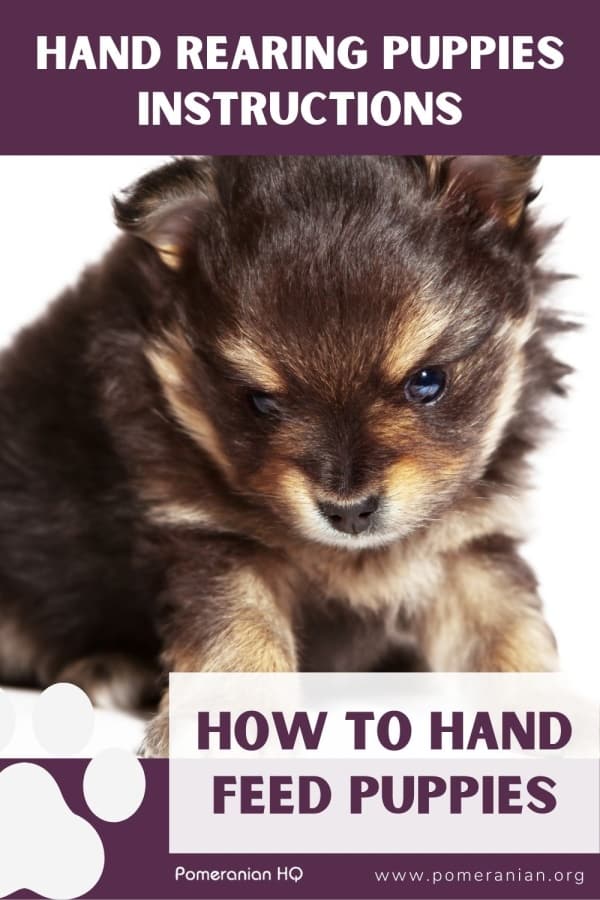Last Updated on 29/11/2023 by Dochlaggie. Post first published on February 26, 2022.
This article will explain all about hand rearing puppies. I have been breeding Pomeranian show dogs for over 45 years and I am sharing my experience in hand rearing puppies.
Pomeranian babies are very small at birth, an average newborn Pomeranian baby weighs between 2 and 5 oz at birth. Puppies must be kept warm, at a constant temperature of 95-100 F (35 – 38 C) the first week.
The temperature can be slowly dropped to 75 F (24 C) after the age of 3 weeks. I personally prefer the use of an overhead infra-red light for heat purposes and I keep a bowl of water nearby to keep the atmosphere near the puppies moist.
It is imperative that the puppies never become dehydrated. You can easily check that puppy is not dehydrated, by pulling a little skin up and checking how quickly the skin returns to normal.
Chilled puppies are unable to digest their food. A chilled puppy must be slowly warmed and stimulated by rubbing prior to feeding.
Can Newborn Puppies Drink Baby Formula?
For those people who want an answer to the question ” can newborn puppies drink baby formula?” The answer is NO.
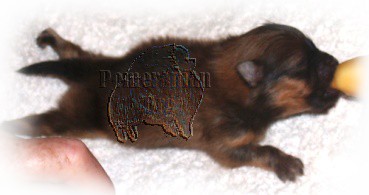
I have had great success hand rearing puppies by feeding goat’s milk, but where possible I prefer to use a puppy formula.
How Often Does a Newborn Puppy Need to Eat?
As a rough guide newborn puppies feeding must be every 2 to 3 hours, 24 hours day for the first couple of weeks. As the puppies get older and bigger the time between feeds can be increased.
Hygiene is very important and all equipment used to feed the puppies should be sterilized between feeds.
Bottle or Tube Feeding Newborn Pomeranian Puppies
Puppies can be fed with a special bottle or you can tube feed. Bottle feeding is a little easier for novice breeders. I have found the biggest problem is making the correct size hole in the teat. Too big and the puppy can nearly choke, or end up with milk in the puppy’s lungs, or milk coming out of the puppy’s nose.
If you find milk coming from the puppy’s nose check the size of the hole in the teat. Also check the roof of the puppy’s mouth for a cleft palate.
I personally prefer to tube feed puppies. Once you have mastered the art of tube feeding, you will find that tube feeding a newborn puppy is the fastest and safest method. Care must be taken to be sure that the tube enters the oesophagus and not the trachea.
Always make a make on the tube as far as from the tip of the nose to the last rib. Then insert the tube to this mark and you can be sure that the tube is correctly inserted.
I would recommend that ask you vet to show you how to tube feed a puppy. The secret to hand rearing is not to overfeed. If the puppies sleep from one feed to the other with nearly no crying and their stools are formed with no undigested curds and they gain weight then the feeding regime is correct.
If you observe undigested food (curds)] in the puppies’ stools, the mixture is too rich for the puppy. If you are using the formula below reduce the amount of whipping cream added (if any). If using a commercial puppy rearing formula, slightly increase the ratio of boiled water to formula.
How Much to Tube Feed a Puppy
A newborn puppy requires 1cc of newborn puppy formula for every ounce of their body weight. Newborn puppies feeding is required every 2 to 3 hours.
Weight Conversion Chart for Tubing Puppies:
1/2 ounce formula = 15cc
1 ounce formula = 30cc
1 ounce = 28.3 grams
How Much Milk Should a Newborn Puppy Drink?
Newborn Puppy Feeding Chart
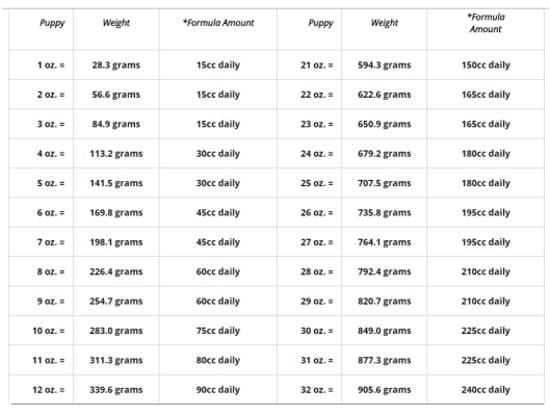
How to Toilet Newborn Puppies
After feeding puppies must be helped to urinate and defecate. I use a wad cotton wool with baby oil to moisten the puppies bottom. If the puppy’s bottom becomes chaffed , use a human baby nappy rash cream to sooth and cure this problem. It is extremely important that all newborn puppies defecates within the first 24 hours.
During the first 24 hours ensure that all the puppies have opened their bowels at least once. Some puppies take longer to defecate and you just must gently rub the area around the anus with the positioned cotton wool wad. Don’t be concerned if your puppy does cry, this is a good sign that he is trying to pass a motion, so keep rubbing until he has success.
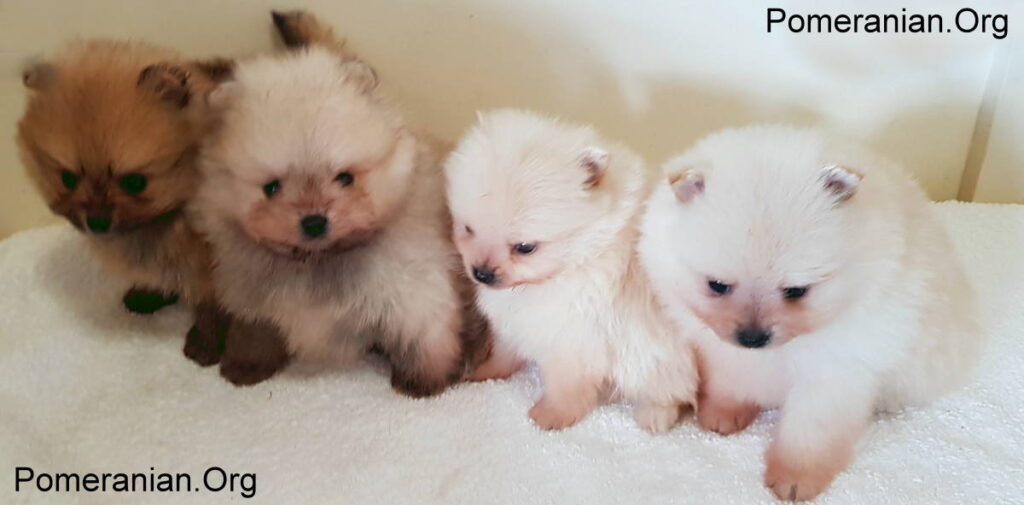
Suitable Replacement Newborn Puppy Formula
I personally prefer to use a commercial puppy rearing formula, but in case of an emergency the following recipes for homemade puppy formula, may prove of use. I have hand reared litters on Recipe 3 with success.
Remember your newborn Pomeranian puppy is very fragile and that any sudden changes to your puppy’s diet could be fatal. Any changes in a puppy’s diet must be made slowly, making small changes each day.
The Puppy formula should be freshly made up for each feed.
How to Change the Newborn Puppy Formula
Great care must be used with any changes in the formula fed to the puppies. Even a change to temperature of the formula if enough to cause stomach upsets in a very small newborn Pomeranian puppy.
If you want to change the puppy from one milk formula to another baby milk for puppies, please do this by feeding 95 % the old formula with 5% the new formula added for the first day. Slowly increase the percentage of new formula day by day until the puppy is 100% on the new formula.
If any stomach upset at all is observed, whilst you are changing the formula, I would stop increasing the percentage of new formula for a few days and maybe even go back one step.

Blood Recipe for Fading and Not Thriving Puppies
1 large piece beef liver Small amount of water Boil in pot for 5 minutes or until the blood comes out of the liver. Set aside until cold. Then strain and keep only the clear blood juice. DO NOT GIVE ANY OF THE LIVER IT IS TOO RICH FOR PUPPIES. Keep in fridge for up to 1 week.
DIRECTIONS: Give 4 drops every 2 hours for 12 hours. Then 4 drops every 4 hours for as long as the puppy needs it.
Newborn Puppy Milk Recipe
The following are homemade puppy formula, including evaporated milk puppy formula that I have used with success.
Puppy Formula Recipe 1
1 cup whole goat milk, 2 egg yolks, 1 teaspoon honey or white corn syrup, 1 teaspoon cold pressed flax oil For weak pups a ¼ cup whipping cream may be added to the above recipe.
Evaporated Milk Puppy Formula Recipe
13 oz. can of evaporated milk. Equal amount of water, 4 oz. of plain yogurt, 4 egg yolks, 1 tablespoon of liquid vitamins. The water element is very important in any formula. The newborn puppy has a tremendous need for water, since he himself is almost 85% water.
Evaporated Milk Puppy Formula 2
50/50 Evaporated Milk and WARM (pre-boiled) water, 1 beaten egg yoke, 1 Teaspoon of Sandoz Calcium, 1 Teaspoon of Glucose Powder, 3 drops of Pentavite Vitamin Drops, Strain with a tea strainer.
Evaporated Milk Puppy Formula 3
12 oz evaporated milk, 3 large egg yolks, 2 tbls of dark karo syrup, 1 cup of plain yogurt (no non fat) mix well then add 8 oz of clear pedialite. Formula keeps for 2 days.
Puppy Formula Recipe 5
4 oz. natural full fat yogurt, 4 oz. full fat evaporated milk (NOT condensed), 1 egg yolk, 1 Tablespoon Mayonnaise, (NOT salad dressing, and NO lite or diet), 1 dropper, (about .6 mls) of a human baby liquid Vitamin…no floride. ABDEC or Poly-Vi-Sol for example. Mix in blender. This is also useful to top up a bitch’s meals, and in weaning to soak kibble.
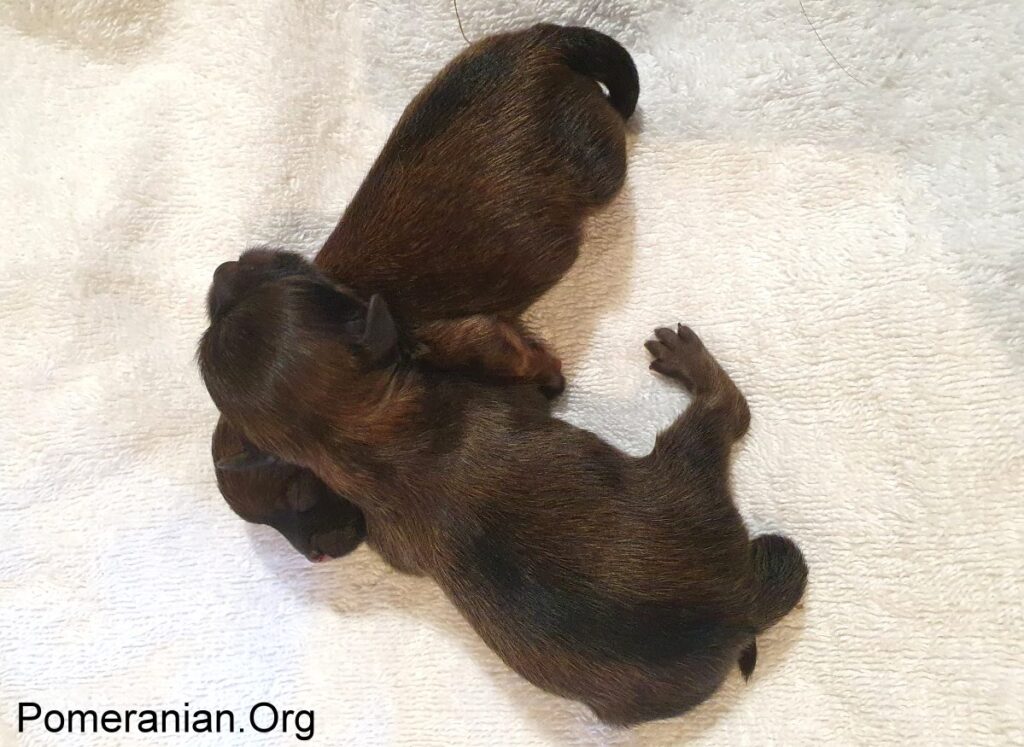
A Guide to Milk for Baby Pomeranian Puppies
Pomeranian dog breeders will have to give puppies supplements at some stage. In an ideal world, all puppies should get a day or two of colostrum fresh from their mum.
After that, supplementing may be needed for a number of reasons including: poor health of the mother, a big litter, the death of the mother or a puppy who has to fight the others to get any milk at all.
The big question is this: are all milk supplements of the same high quality? Are they safe to use instead of the proper mother’s milk?
A study in a issue of the Journal of the American Veterinary Medical Association (JAVMA) raises two concerns. This study blatantly claims that milk replacers aren’t a full substitute for mother’s milk.
One topic that the news has reported on a lot for numerous species is polyunsaturated fatty acids – and, more specifically – ARA (arachidonic acid) and DHA (docosahexaenoic acid).These fatty acids have been related to normal brain and retinal development in various mammals.
They’re added to baby formulas currently as well. As for puppies, these acids help with visual acuity, memory and their ability to learn.
There are other ingredients that are also needed in order for healthy growth to occur. They include: calories, phosphorus and calcium.
The specific nutritional needs of puppies have never been defined fully but it’s a natural assumption that canine milk meets all those needs. The study compared five samples from nursing mothers with puppies aged 2-3 weeks with 15 different milk replacers and there were some glaring deficiencies. Although the replacers had sufficient protein, the right makeup of amino acids wasn’t adequate.
For example, Arginine is essential for the healthy development of canines and a deficiency can cause cataracts, especially in larger breeds of puppies. Both goat and cow milk both lack this substance in any definable amounts.
This is bad news as most replacers contain one of these milk types. Calcium usually isn’t as high in replacers and the phosphorus to calcium balances weren’t right. There wasn’t enough fatty acids and ARA and DHA were usually missing from the replacers.
However, what was found to be higher in replacers than in the mother’s milk was sugar levels (particularly lactose).The researchers were also concerned about the fact that directions for feeding were usually calculated based on volume, instead of the density of the calories.
There was also a severe shortage of information available to teach dog owners how to adjust the quantity they fed their pets as they grew older. So, the question still remains…what should a breeder do if he needs to give his dog supplements?
Commercial supplements may be slightly better than home-made versions simply because they’re created to be good quality, if not perfect. The smaller and/or weaker puppies are usually more in need of the milk replacers. They need a better diet more than some of the bigger pups.
You may need to pull bigger ones off the mother so the smaller ones can get the ideal nutrition required. You can give a milk replacer to the bigger puppies with less side effects.
A perfect solution would be to find a mother who has puppies the same age and can take on some extras.
A female Pomeranian with only two Pomeranian pups can easily take on another one and this eases one mother’s burden of hungry baby Pomeranians. Ensure your female Pomeranian is being fed the best possible food so her milk is of the highest possible quality so her pups can get all that vital nutrition.
If you need to use milk replacer, talk to a veterinary nutritionist so you can make sure your pups are receiving enough of the right nutrients. He/she can give you ideas about other possible supplements that may be required. Breeders will need to use commercially-made milk replacers some of the time.
Always check the quality of such items and try to ensure the pups who need the mother’s milk the most actually get it first.
Milk for Baby Pomeranians

Hand Rearing Puppies Conclusion
Hand rearing a puppy is hard work, but when you succeed in saving a tiny life all the sleepless nights are worthwhile.
Please note: while I do discuss health, care, and behavioral issues, you should never use this information as a replacement for advice from qualified veterinarians, diagnoses, or recommended treatment regimes. If you have any worries about the health of your Pomeranian, your first contact should be your regular vet or, if you don’t yet have one, a vet that works locally. Never ignore or avoid treatment and advice from your vet because of a piece of information you have read on any website.
Copyright Pomeranian.org. All Rights Reserved.
References and Further Reading:
[1] Official Standard of the Pomeranian (AKC). American Kennel Club, 2011.
[2] English Kennel Club Pomeranian Breed Standard, 2017.
[3] Denise Leo, The Pomeranian Handbook.
[4] Milo G. Denlinger “The Complete Pomeranian.”
[5] Kimbering Pomeranians “1891-1991”.
[6] William Taplin’s “The Sportsman’s Cabinet.”
[7] E. Parker “The Popular Pomeranian.”
[8] Lilla Ives “Show Pomeranians.”
The Pomeranian Handbook
